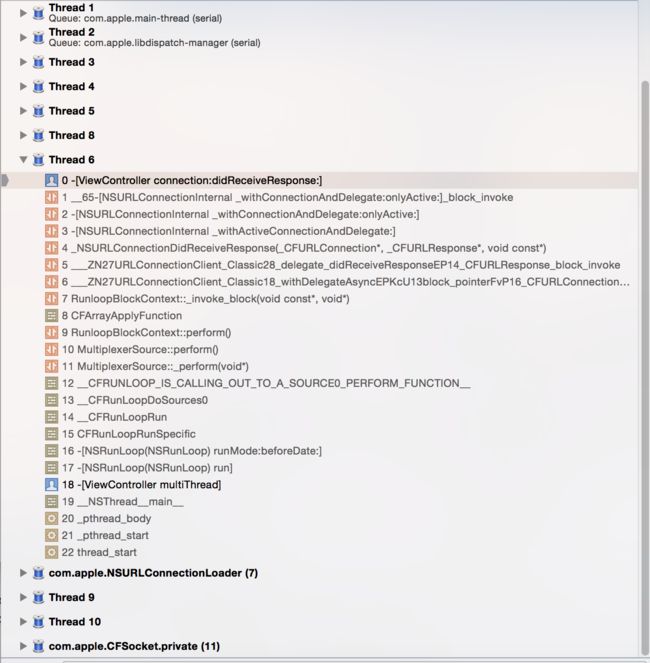在CFRunloop中已经说明了一个线程及其runloop的对应关系 ,现在以iOS中NSThread的实际使用来说明runloop在线程中的意义。
在iOS中直接使用NSThread有一下几种方式,但是归根到底,当一个线程需要长时间的去跟踪一个任务的时候,这几种方式做的事情是一样的,只不过接口名称和参数不一样,感觉是为了使用起来更加方便。因为这些接口内部都需要依赖runloop去实现事件的监听,这个可以通过调用堆栈证实。
- (void)performSelectorInBackground:(SEL)aSelector withObject:(id)arg
- (void)performSelector:(SEL)aSelector onThread:(NSThread*)thr withObject:(id)arg waitUntilDone:(BOOL)wait
以上两个方法都是NSObject的方法,可以直接通过一个对象来创建一个线程。第二个方法具有更多的灵活性,它可以让你自己指定线程,第一个方法是自己默认创建一个线程。第二个方法的最后一个参数是指定是否等待aSelector执行完毕。
+ (void)detachNewThreadSelector:(SEL)selector toTarget:(id)target withObject:(id)argument;
该方法是NSThread的类方法,跟第一个方法是类似的功能。
下面通过在子线程发起一个网络请求,去发现一些问题,然后通过runloop去解释原因,并推测API背后的实现方式。
代码1
- (void)viewDidLoad {
[super viewDidLoad];
[self performSelectorInBackground:@selector(multiThread) withObject:nil];
}
- (void)multiThread
{
if (![NSThread isMainThread]) {
self.request = [[NSMutableURLRequest alloc]
initWithURL:[NSURL URLWithString:@"
http://www.baidu.com"]
cachePolicy:NSURLCacheStorageNotAllowed
timeoutInterval:10];
[self.request setHTTPMethod: @"GET"];
self.connection =[[NSURLConnection alloc] initWithRequest:self.request
delegate:self
startImmediately:YES];
}
}
- (void)connection:(NSURLConnection *)connection didReceiveResponse:(NSURLResponse *)response{
NSLog(@"network callback");
}
运行之后,可以发现在子线程中发起的网络请求,回调没有被调用。根据CFRunloop介绍的知识可以大致猜测可能跟runloop有关系,也就是子线程的runloop中没有注册网络回调的消息,所以该子线程自己相关的runloop没有收到回调。实际上
- (instancetype)initWithRequest:(NSURLRequest *)request delegate:(id)delegate startImmediately:(BOOL)
这个方法的第三个参数的bool值表示是否在创建完NSURLConnection对象之后立刻发起请求,一般情况下是YES,什么时候会传NO呢。
事实上,对于以上这种方式创建的线程,默认是没有生成该线程对应的runloop的。也就是说这种情况下,需要自己去创建对应线程的runloop,并且让他run起来,去不断监听各种往runloop里注册的消息。但是对于主线程而言,其对应的runloop会由系统建立,并且自己run起来。由于平时工作在主线程下,这些工作大部分情况下不需要人为参与,所以一到子线程就会有各种问题。子线程中起timer没有生效也是相同的原因。所以以上函数第三个参数的意思就是,如果是当前线程已经runloop跑起来的情况下,传YES。除此之外,需要自己创建runloop去run,再将网络请求消息注册到runloop中。
现在根据以上分析修改代码:
代码2
self.request = [[NSMutableURLRequest alloc]
initWithURL:[NSURL URLWithString:@"http://
www.baidu.com"]
cachePolicy:NSURLCacheStorageNotAllowed
timeoutInterval:10];
[self.request setHTTPMethod: @"GET"];
self.connection =[[NSURLConnection alloc] initWithRequest:self.request
delegate:self
startImmediately:NO];
NSRunLoop *runLoop = [NSRunLoop currentRunLoop];
[runLoop run];
[self.connection scheduleInRunLoop:[NSRunLoop currentRunLoop] forMode:NSDefaultRunLoopMode];
[self.connection start];
代码3
self.request = [[NSMutableURLRequest alloc]
initWithURL:[NSURL URLWithString:@"http://
www.baidu.com"]
cachePolicy:NSURLCacheStorageNotAllowed
timeoutInterval:10];
[self.request setHTTPMethod: @"GET"];
self.connection =[[NSURLConnection alloc] initWithRequest:self.request
delegate:self
startImmediately:NO];
NSRunLoop *runLoop = [NSRunLoop currentRunLoop];
[self.connection scheduleInRunLoop:[NSRunLoop currentRunLoop] forMode:NSDefaultRunLoopMode];
[self.connection start];
[runLoop run];
然后就发现网络回调被调用了。
之后分析了一下调用堆栈:
第一个:在multiThread里面是这样的:
第二个:网络回调里面是这样的:
通过堆栈可以得知,这两个函数都是由线程6调用的,也就是创建的子线程,也就是创建的子线程,但是堆栈中的内容很不一样。很显然第二个是从runloop 调出的,并且是Sources0这个消息调出的。而第一个是线程运行时候的初始化方法。所以当调用runloop run的时候,其实是线程进入自己的runloop去监听时间了,从此以后,所有的代码都会从runloop CALLOUT出来。所以这种情况下,需要把先把消息注册到runloop中,让runloop跑起来是最后需要做的事情。
以下是开源库AFNetworking网络请求的实现:
AFNetworking
- (void)start {
[self.lock lock];
if ([self isCancelled]) {
[self performSelector:@selector(cancelConnection) onThread:[[self class
] networkRequestThread] withObject:nil waitUntilDone:NO modes:[self.
runLoopModes allObjects]];
} else if ([self isReady]) {
self.state = AFOperationExecutingState;
[self performSelector:@selector(operationDidStart) onThread:[[self
class] networkRequestThread] withObject:nil waitUntilDone:NO modes:[
self.runLoopModes allObjects]];
}
[self.lock unlock];
}
+ (void)networkRequestThreadEntryPoint:(id)__unused object {
@autoreleasepool {
[[NSThread currentThread] setName:@"AFNetworking"];
NSRunLoop *runLoop = [NSRunLoop currentRunLoop];
[runLoop addPort:[NSMachPort port] forMode:NSDefaultRunLoopMode];
[runLoop run];
}
}
+ (NSThread *)networkRequestThread {
static NSThread *_networkRequestThread = nil;
static dispatch_once_t oncePredicate;
dispatch_once(&oncePredicate, ^{
_networkRequestThread = [[NSThread alloc] initWithTarget:self selector:
@selector(networkRequestThreadEntryPoint:) object:nil];
[_networkRequestThread start];
});
return _networkRequestThread;
}
AFNetworking使用的是
- (void)performSelector:(SEL)aSelector onThread:(NSThread\*)thr withObject:(id)arg waitUntilDone:(BOOL)wait
这个方法,但是为什么它没有使用
- (void)performSelectorInBackground:(SEL)aSelector withObject:(id)arg
这个方法呢?
通过断点,发现了AFNetwokring网络请求中一些函数的调用顺序:
1.networkRequestThread
2.networkRequestThreadEntryPoint
3.operationDidStart
为什么operationDidStart会在networkRequestThreadEntryPoint之后调用?
在networkRequestThreadEntryPoint里主要是生成网络线程的runloop并且让它跑起来,里面的
[runLoop addPort:[NSMachPort port] forMode:NSDefaultRunLoopMode]
这主要是为了在没有任何网络请求的时候让网络线程保持监听状态,否则网络线程的loop会直接返回,之后再调用网络线程请求就没有意义了。再结合调用堆栈,发现operationDidStart是在runloop callout出来的,而networkRequestThreadEntryPoint是网络线程的入口方法。这跟之前的例子是一样的。所以,我猜测
- (void)performSelector:(SEL)aSelector onThread:(NSThread\*)thr withObject:(id)arg waitUntilDone:(BOOL)wait
这个方法背后是由主线程将aSelector作为消息注册到runloop中时间发生在networkRequestThreadEntryPoint方法调用之前,所以在networkRequestThreadEntryPoint方法中调用 。 NSRunLoop currentRunLoop的时候其实runloop本身应该已经被创建了。原因是因为在这个地方断点 ,打印runloop对象可以发现里面已经注册了source0的消息,如下截图:
也就是说父线程在
- (void)performSelector:(SEL)aSelector onThread:(NSThread *)thr withObject:(id)arg waitUntilDone:(BOOL)wait**函数中将aSelector
注册成source0,这是该函数背后的大致实现。通过查阅apple官方文档,基本属实,如下所示:
通过上面的分析,可以得出使用performSelector方法可以将子线程runloop的初始化实现在子线程的初始化方法里实现,如果使用performSelectorInBackground
方法,那么子线程runloop的初始化和业务逻辑就会混到一起,并且每一次都会重新初始化。AFNetworking通过一个静态全局的子线程去管理所有的网络请求,其对应的runloop也只需要初始化一次。
通过以上分析,可以知道如果需要让一个子线程去持续的监听时间,就需要启动它的runloop并且忘其中注册source,timer,oberserver三者之一的消息类型。在默认情况下子线程的runloop是不会自己创建和启动的。
线程之间的通讯:NSMachPort
NSNotificationCenter是iOS中全局的观察者,可以用于不同页面之间消息传递解耦。
先看一段代码:
代码1
@implementation ViewController
- (void)viewDidLoad {
[super viewDidLoad];
NSLog(@"current thread = %@", [NSThread currentThread]);
[[NSNotificationCenter defaultCenter] addObserver:self selector:@selector(
handleNotification:) name:TEST_NOTIFICATION object:nil];
dispatch_async(dispatch_get_global_queue(DISPATCH_QUEUE_PRIORITY_DEFAULT, 0
), ^{
[[NSNotificationCenter defaultCenter] postNotificationName:TEST_NOTIFICATION object:nil userInfo:nil];
});
}
- (void)handleNotification:(NSNotification *)notification
{
NSLog(@"current thread = %@", [NSThread currentThread]);
NSLog(@"test notification");
}
@end
输出如下:
输出
current thread = {number = 1, name = main}
current thread = {number = 2, name = (null)}
test[865:45174] test notification
在主线程中注册了一个通知,在子线程中抛出事件,最后在子线程中处理事件。
但是有些时候,可能需要在同一个线程中处理事件,比如更新UI的操作只能放到主线程中进行。所以,需要做一次线程之间消息的转发。如果是子线程往主线程转发,通过GCD即可实现。但是如果是任意两个线程之间通讯,则需要依赖NSMachPort通过它往目标线程的runloop中注册事件来完成。
@interface ViewController ()
@property (nonatomic) NSMutableArray *notifications; // 通知队列
@property (nonatomic) NSThread *notificationThread; // 期望线程
@property (nonatomic) NSLock *notificationLock; // 用于对通知队列加锁的锁对象,避免线程冲突
@property (nonatomic) NSMachPort *notificationPort; // 用于向期望线程发送信号的通信端口
@end
@implementation ViewController
- (void)viewDidLoad {
[super viewDidLoad];
NSLog(@"current thread = %@", [NSThread currentThread]);
// 初始化
self.notifications = [[NSMutableArray alloc] init];
self.notificationLock = [[NSLock alloc] init];
self.notificationThread = [NSThread currentThread];
self.notificationPort = [[NSMachPort alloc] init];
self.notificationPort.delegate = self;
// 往当前线程的run loop添加端口源
// 当Mach消息到达而接收线程的run loop没有运行时,则内核会保存这条消息,直到下一次进入run loop
[[NSRunLoop currentRunLoop] addPort:self.notificationPort
forMode:(__bridge NSString *)
kCFRunLoopCommonModes];
[[NSNotificationCenter defaultCenter] addObserver:self selector:@selector(
processNotification:) name:@"TestNotification" object:nil];
dispatch_async(dispatch_get_global_queue(DISPATCH_QUEUE_PRIORITY_DEFAULT, 0
), ^{
[[NSNotificationCenter defaultCenter] postNotificationName:TEST_NOTIFICATION object:nil userInfo:nil];
});
}
//NSMacPort回调方法
- (void)handleMachMessage:(void *)msg {
[self.notificationLock lock];
while ([self.notifications count]) {
NSNotification *notification = [self.notifications objectAtIndex:0];
[self.notifications removeObjectAtIndex:0];
[self.notificationLock unlock];
[self processNotification:notification];
[self.notificationLock lock];
};
[self.notificationLock unlock];
}
- (void)processNotification:(NSNotification *)notification {
if ([NSThread currentThread] != _notificationThread) {
// Forward the notification to the correct thread.
[self.notificationLock lock];
[self.notifications addObject:notification];
[self.notificationLock unlock];
[self.notificationPort sendBeforeDate:[NSDate date]
components:nil
from:nil
reserved:0];
}
else {
// Process the notification here;
NSLog(@"current thread = %@", [NSThread currentThread]);
NSLog(@"process notification");
}
}
@end
输入如下:
test[1474:92483] current thread = {number = 1, name = main}
test[1474:92483] current thread = {number = 1, name = main}
test[1474:92483] process notification



